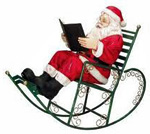 With the holidays quickly approaching many families have begun decorating their homes, shopping for presents and making plans for the new year. Two important presents teachers give their students each year are a book filled classroom and the love of reading. In theses last few weeks of school continue sharing the gift of books by reading aloud a title from this list. The International Reading Association's Children's Literature and Reading Special Interest Group (CL/R SIG) wishes everyone a happy holiday!
With the holidays quickly approaching many families have begun decorating their homes, shopping for presents and making plans for the new year. Two important presents teachers give their students each year are a book filled classroom and the love of reading. In theses last few weeks of school continue sharing the gift of books by reading aloud a title from this list. The International Reading Association's Children's Literature and Reading Special Interest Group (CL/R SIG) wishes everyone a happy holiday!
GRADES K-3
Alko, Selina. (2012). Daddy Christmas and Hanukkah Mama. New York: Alfred A. Knopf.
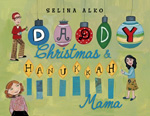 Young Sadie launches the family holiday season with her declaration, “I am a mix of two traditions.” In simple text but vivid and playful gouache, collage and colored pencil illustrations the author describes how this household celebrates Christmas and Hanukkah. Father is Christian and mother is Jewish, yet the reader will find dad making latkes (for Santa, no less!) and kugel dressing for turkey dinner. He hangs candy canes from the menorah on the mantel. As relatives arrive and dinner is served, the extended family share stories about holiday traditions. This unique family situation provides a great conversation starter for those interested in a truly multicultural look at the holidays. Learn more about the author and her books at her website.
Young Sadie launches the family holiday season with her declaration, “I am a mix of two traditions.” In simple text but vivid and playful gouache, collage and colored pencil illustrations the author describes how this household celebrates Christmas and Hanukkah. Father is Christian and mother is Jewish, yet the reader will find dad making latkes (for Santa, no less!) and kugel dressing for turkey dinner. He hangs candy canes from the menorah on the mantel. As relatives arrive and dinner is served, the extended family share stories about holiday traditions. This unique family situation provides a great conversation starter for those interested in a truly multicultural look at the holidays. Learn more about the author and her books at her website.
- Karen Hildebrand, Ohio Library and Reading Consultant
Andreasen, Dan. (2012). The twelve days of Christmas. Mankato, MN.: Sleeping Bear Press.
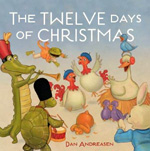 Though there are numerous book versions of this traditional Christmas song, author/artist Dan Andreasen has created a new volume specifically intended for young readers. A baby partridge begins the story song and each day a new cast of characters arrives illustrated with playful animal characters that prove to overwhelm the young partridge. Funny-looking turtledoves, cats that are milkmaids, rabbits performing as dancing ladies and tortoises banging on drums start the mayhem. Though the words remain the same, this is a fresh look at a traditional English carol for young readers counting the days toward the Christmas holiday.
Though there are numerous book versions of this traditional Christmas song, author/artist Dan Andreasen has created a new volume specifically intended for young readers. A baby partridge begins the story song and each day a new cast of characters arrives illustrated with playful animal characters that prove to overwhelm the young partridge. Funny-looking turtledoves, cats that are milkmaids, rabbits performing as dancing ladies and tortoises banging on drums start the mayhem. Though the words remain the same, this is a fresh look at a traditional English carol for young readers counting the days toward the Christmas holiday.
- Karen Hildebrand, Ohio Library and Reading Consultant
Black, Birdie. (2012). Just right for Christmas. Illus. by Rosalind Beardshaw. New York: Nosy Crow Publisher/Candlewick.
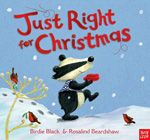 For teachers looking for a read aloud about the joy of giving, this new book from Birdie Black is just that right book including repeating phrases that young readers will want to join in with the teacher, especially “That cloth is so red and soft and Christmassy!” This phrase opens the book as the king strolls through the market on Christmas Eve and sees a bolt of red cloth that he knows is just right for a grand cloak for his daughter. When the king’s seamstresses finish the cloak, they put the scraps outside the back door. The kitchen maid walks by and sees the discarded red scraps and she immediately decides to make a jacket for her ma. When she discards the scraps, along comes a badger who sees that he can make a hat for his pa; then a squirrel gathers the scraps to make gloves for his wife; and from the last bits of red cloth a mouse makes a beautiful red scarf for her son. The final pages bring all the characters from the book together at the ice skating rink and readers will see all the red gifts sported around the ice rink. The mixed media illustrations use cloth and patterns and sewing items that add a touch of homespun storytelling to the story. Pair this with Simms Taback’s Caldecott winner, Joseph Had a Little Overcoat. A quick book talk of this book can be found at YouTube.
For teachers looking for a read aloud about the joy of giving, this new book from Birdie Black is just that right book including repeating phrases that young readers will want to join in with the teacher, especially “That cloth is so red and soft and Christmassy!” This phrase opens the book as the king strolls through the market on Christmas Eve and sees a bolt of red cloth that he knows is just right for a grand cloak for his daughter. When the king’s seamstresses finish the cloak, they put the scraps outside the back door. The kitchen maid walks by and sees the discarded red scraps and she immediately decides to make a jacket for her ma. When she discards the scraps, along comes a badger who sees that he can make a hat for his pa; then a squirrel gathers the scraps to make gloves for his wife; and from the last bits of red cloth a mouse makes a beautiful red scarf for her son. The final pages bring all the characters from the book together at the ice skating rink and readers will see all the red gifts sported around the ice rink. The mixed media illustrations use cloth and patterns and sewing items that add a touch of homespun storytelling to the story. Pair this with Simms Taback’s Caldecott winner, Joseph Had a Little Overcoat. A quick book talk of this book can be found at YouTube.
- Karen Hildebrand, Ohio Library and Reading Consultant
Bryan, Ashley. (2012). Who built the stable?; a nativity poem. New York: Atheneum Books for Young Readers.
 Told in rhymed couplets and illustrated with the brilliantly familiar artwork of Ashley Bryan, this story of the nativity brings new thought to the original story of Christmas. The narrator is a young boy apprenticed to his father and training to be a carpenter. When Mary and Joseph arrive in Bethlehem, the young apprentice invites them to stay in the stable. As Ashley Bryan was traveling in an open Jeep across Africa, the bumpy terrain reminded him of the bumpy journey Mary made all those years ago to Bethlehem. Throughout this new book, Bryan has illustrated the pictures with a strong African influence including background pictures of a giraffe, a zebra, a monkey, and an African drummer. Some observers might question these artistic details, but it brings universality to this glorious birth. After the young carpenter boy has cared for Mary and Joseph’s comforts for the coming night, he greets them in the morning and meets the new babe. He proclaims that this child will also be a carpenter and a shepherd. This vibrant new book brings a new slant to the Biblical version as young readers enjoy the story told in rich language with beautiful illustrations. This would make an excellent family story or gift for Christmas. Listen to a podcast on the illustrations of Ashley Bryan.
Told in rhymed couplets and illustrated with the brilliantly familiar artwork of Ashley Bryan, this story of the nativity brings new thought to the original story of Christmas. The narrator is a young boy apprenticed to his father and training to be a carpenter. When Mary and Joseph arrive in Bethlehem, the young apprentice invites them to stay in the stable. As Ashley Bryan was traveling in an open Jeep across Africa, the bumpy terrain reminded him of the bumpy journey Mary made all those years ago to Bethlehem. Throughout this new book, Bryan has illustrated the pictures with a strong African influence including background pictures of a giraffe, a zebra, a monkey, and an African drummer. Some observers might question these artistic details, but it brings universality to this glorious birth. After the young carpenter boy has cared for Mary and Joseph’s comforts for the coming night, he greets them in the morning and meets the new babe. He proclaims that this child will also be a carpenter and a shepherd. This vibrant new book brings a new slant to the Biblical version as young readers enjoy the story told in rich language with beautiful illustrations. This would make an excellent family story or gift for Christmas. Listen to a podcast on the illustrations of Ashley Bryan.
- Karen Hildebrand, Ohio Library and Reading Consultant
Carpenter, Tad. (2012). Sad Santa. New York: Sterling Children’s Books.
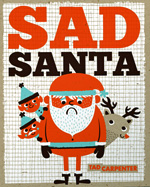 It is December 26, and Santa is sad. The presents are open, the cookies are eaten, and everyone is forgetting about Santa. He has the blues. Mrs. Claus tries to cheer him up and suggests going on a beach vacation but this doesn’t work as he just doesn’t feel wanted or needed any longer. Then, one day, a letter arrives from a young boy who is starting on his Christmas list for next year. He is asking for gifts for his brother and his parents. Santa’s enthusiasm returns and he heads for the North Pole to begin the new season’s extra-special gifts. Though he is back to work, the end of the book concludes with Santa’s thought about sharing and the spirit of giving and caring every day of the year. The author got the idea for this book after his recent marriage. The planning of the wedding took months and months and then was over so quickly, it made him think of Christmas in the same way. Enjoy the website dedicated to this book.
It is December 26, and Santa is sad. The presents are open, the cookies are eaten, and everyone is forgetting about Santa. He has the blues. Mrs. Claus tries to cheer him up and suggests going on a beach vacation but this doesn’t work as he just doesn’t feel wanted or needed any longer. Then, one day, a letter arrives from a young boy who is starting on his Christmas list for next year. He is asking for gifts for his brother and his parents. Santa’s enthusiasm returns and he heads for the North Pole to begin the new season’s extra-special gifts. Though he is back to work, the end of the book concludes with Santa’s thought about sharing and the spirit of giving and caring every day of the year. The author got the idea for this book after his recent marriage. The planning of the wedding took months and months and then was over so quickly, it made him think of Christmas in the same way. Enjoy the website dedicated to this book.
- Karen Hildebrand, Ohio Library and Reading Consultant
Kelleher, Kathie. (2012). The night before Christmas, deep under the sea. Illus. by Dan Andreasen. New York: Holiday House.
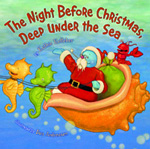 For those collectors of all the parodies and varieties of Clement Moore’s poem, “The Night Before Christmas,” here is a new addition/edition. Narrated by a jolly old lobster, readers will find the undersea marine setting a humorous touch to the traditional poem. Mermaids replace peeking children in this tale of underwater Christmas. When Santa finally arrives, readers will see that he is a blue walrus and sea horses with their own marine names pull the conch-shell sleigh. Using oil and digital artwork the illustrations are often double page spreads that add a luminescence for underwater effect in addition to humorously supporting the text that stays admiringly close to Moore’s original.
For those collectors of all the parodies and varieties of Clement Moore’s poem, “The Night Before Christmas,” here is a new addition/edition. Narrated by a jolly old lobster, readers will find the undersea marine setting a humorous touch to the traditional poem. Mermaids replace peeking children in this tale of underwater Christmas. When Santa finally arrives, readers will see that he is a blue walrus and sea horses with their own marine names pull the conch-shell sleigh. Using oil and digital artwork the illustrations are often double page spreads that add a luminescence for underwater effect in addition to humorously supporting the text that stays admiringly close to Moore’s original.
- Karen Hildebrand, Ohio Library and Reading Consultant
Matteson, George, & Ursone, Adele. (2012). The Christmas tugboat: How the Rockefeller Center Christmas Tree came to New York City. Illus. by James Ransome. Boston/New York: Houghton Mifflin Books/Clarion Books.
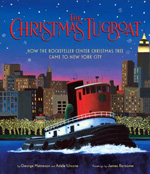 Many young readers will cherish this book that explains how the huge Christmas tree that graces New York City's Rockefeller Center at Christmas arrives at its destination. Although the story does not cover the selection and the cutting of the tree chosen for this honor, it describes its watery journey along the Hudson River. Based on their own experiences, the authors relate how one family ventures out in a tugboat along the river to guide the tree to its rightful place of honor. The story highlights family love and how the three family members take note of everything along their path while the acrylic illustrations paint the city and its surroundings in eye-catching style, making the route back to NYC seem almost like a parade attended by passengers in boats. Although many readers will be familiar with the lighting of the tree at the Rockefeller Center, few of them will have considered how the tree would be transported. This is a perfect read aloud as the holiday season draws nigh.
Many young readers will cherish this book that explains how the huge Christmas tree that graces New York City's Rockefeller Center at Christmas arrives at its destination. Although the story does not cover the selection and the cutting of the tree chosen for this honor, it describes its watery journey along the Hudson River. Based on their own experiences, the authors relate how one family ventures out in a tugboat along the river to guide the tree to its rightful place of honor. The story highlights family love and how the three family members take note of everything along their path while the acrylic illustrations paint the city and its surroundings in eye-catching style, making the route back to NYC seem almost like a parade attended by passengers in boats. Although many readers will be familiar with the lighting of the tree at the Rockefeller Center, few of them will have considered how the tree would be transported. This is a perfect read aloud as the holiday season draws nigh.
- Barbara A. Ward, Washington State University Pullman
Patricelli, Leslie. (2012). Fa la la. Somerville, MA: Candlewick.
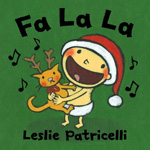 As is often the case for little ones, Baby is beyond excited as Christmas approaches. Eager for Christmas to come, he seizes every chance to get involved in the festivities, even draping tinsel and lights around himself while his parents attempt to decorate the tree. Parents reading this board book to their own little ones will smile at the less-than-desirable but heartfelt presents that Baby makes for his own parents since they may have received similar gifts themselves. It's all lots of fun, accompanied by vividly-hued acrylic illustrations, and Baby's irrepressible joy for life. Readers will chortle as Baby belts out Christmas carols in a decidedly off key fashion to the annoyance of the family's pets who seek solace from the noise. It’s a good thing the holiday comes only once a year.
As is often the case for little ones, Baby is beyond excited as Christmas approaches. Eager for Christmas to come, he seizes every chance to get involved in the festivities, even draping tinsel and lights around himself while his parents attempt to decorate the tree. Parents reading this board book to their own little ones will smile at the less-than-desirable but heartfelt presents that Baby makes for his own parents since they may have received similar gifts themselves. It's all lots of fun, accompanied by vividly-hued acrylic illustrations, and Baby's irrepressible joy for life. Readers will chortle as Baby belts out Christmas carols in a decidedly off key fashion to the annoyance of the family's pets who seek solace from the noise. It’s a good thing the holiday comes only once a year.
- Barbara A. Ward, Washington State University Pullman
Schuette, Sara L. (2012). A Christmas cookbook; simple recipes for kids. Mankato, MN: Capstone Press.
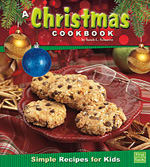 Christmas also means cooking! This cookbook is especially designed for young children to enjoy as the subtitle indicates: simple recipes for kids. Large print, simple step-by-step instructions, and color photographs makes this an ideal Christmas cookbook for young readers. Starting with an introduction on Festive Foods that provides a metric conversion chart, kitchen tools and techniques (crush, drizzle, fold, measure, spread, sprinkle, stir, toss) recipes for snacks and drinks will make apprentice child cooks proud of the kitchen products they produce. Recipes include: North Pole Pie, Blitzen’s Bagels, Hawaiian Snowball Salad, Santa’s Salsa Rolls, Stuffed Sleigh Sammies, and of course, Mrs. Claus Cookies and a Popcorn Garland. A glossary and index help with definitions of specific cooking terms. Yummy! Good news for Santas everywhere!
Christmas also means cooking! This cookbook is especially designed for young children to enjoy as the subtitle indicates: simple recipes for kids. Large print, simple step-by-step instructions, and color photographs makes this an ideal Christmas cookbook for young readers. Starting with an introduction on Festive Foods that provides a metric conversion chart, kitchen tools and techniques (crush, drizzle, fold, measure, spread, sprinkle, stir, toss) recipes for snacks and drinks will make apprentice child cooks proud of the kitchen products they produce. Recipes include: North Pole Pie, Blitzen’s Bagels, Hawaiian Snowball Salad, Santa’s Salsa Rolls, Stuffed Sleigh Sammies, and of course, Mrs. Claus Cookies and a Popcorn Garland. A glossary and index help with definitions of specific cooking terms. Yummy! Good news for Santas everywhere!
- Karen Hildebrand, Ohio Library and Reading Consultant
Whelan, Gloria. (2012). Smudge and the book of mistakes; a Christmas story. Illus. by Stephen Costanza. Mankato, MN: Sleeping Bear Press.
 Fifteen-year-old Cuthbert is sent to live at the monastery of St. Ambrose on the Irish island of Moracrrick. Living in the Middle Ages and small for his age, his father thinks Cuthbert will never be a warrior and the life of a monk is more suited to him. When he is assigned to the scriptorium to learn the art of writing and creating illuminated letters, Brother Cuthbert is delighted. He loves writing and creating the beautiful letters, though most of the time he is a bit sloppy and quickly earns the nickname “Smudge.” A special project is started at the monastery and is designed to bring fame to the church but due to a mistake in assignments, Cuthbert is selected over the best writer/calligrapher at St. Ambrose to be the illuminator of the Christmas story project. Smudge?? Brother Gregory lends Brother Cuthbert guidance and confidence that he can, indeed, complete this project. Through hard work, diligence and many hours of practice, Cuthbert works his way through this momentous task. When a mistake at the very end of the manuscript threatens to completion of the project. Brother Gregory shows Cuthbert how to turn a mistake into something creative and beautiful. Check out "5 Questions With... Gloria Whelan" on the Engage blog. Teachers might like to try teaching students to practice making an illuminated letter.
Fifteen-year-old Cuthbert is sent to live at the monastery of St. Ambrose on the Irish island of Moracrrick. Living in the Middle Ages and small for his age, his father thinks Cuthbert will never be a warrior and the life of a monk is more suited to him. When he is assigned to the scriptorium to learn the art of writing and creating illuminated letters, Brother Cuthbert is delighted. He loves writing and creating the beautiful letters, though most of the time he is a bit sloppy and quickly earns the nickname “Smudge.” A special project is started at the monastery and is designed to bring fame to the church but due to a mistake in assignments, Cuthbert is selected over the best writer/calligrapher at St. Ambrose to be the illuminator of the Christmas story project. Smudge?? Brother Gregory lends Brother Cuthbert guidance and confidence that he can, indeed, complete this project. Through hard work, diligence and many hours of practice, Cuthbert works his way through this momentous task. When a mistake at the very end of the manuscript threatens to completion of the project. Brother Gregory shows Cuthbert how to turn a mistake into something creative and beautiful. Check out "5 Questions With... Gloria Whelan" on the Engage blog. Teachers might like to try teaching students to practice making an illuminated letter.
- Karen Hildebrand, Ohio Library and Reading Consultant
GRADES 4-6
Kalz, Jill. (2012). Christmas chaos: Hidden picture puzzles. Illus. by James Yamasaki. Mankato, MN: Heinemann/Picture Window Books.
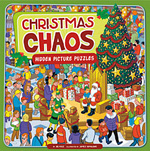 Fourteen puzzles created around a holiday theme give readers a chance to test their patience and enhance their visual literacy and puzzle-solving skills as they try to locate various hard-to-find objects such as a rocking horse, a candy cane, and mistletoe, among others. Although finding them might seem easy, some of the puzzles require combing over the images slowly and patiently several times since the colors blend together. This entertaining book will keep young readers busy as they try to spot all the objects, but don’t be surprised if they ask older readers for some help. Despite the book's title, it also features puzzles about Hanukkah, Kwanzaa, and New Year's as well as a puzzle about the winter season. Many of the pages feature friendly figures enjoying the lighted houses and ice sculptures in their neighborhood as well as standing in line to visit Santa Claus. Successful puzzle solvers can return to the puzzles to look for even more objects, including a cupcake, a mermaid, and a lizard, of all things. While reading this book is great fun, looking at the multi-hued pictures for too long can be headache-inducing.
Fourteen puzzles created around a holiday theme give readers a chance to test their patience and enhance their visual literacy and puzzle-solving skills as they try to locate various hard-to-find objects such as a rocking horse, a candy cane, and mistletoe, among others. Although finding them might seem easy, some of the puzzles require combing over the images slowly and patiently several times since the colors blend together. This entertaining book will keep young readers busy as they try to spot all the objects, but don’t be surprised if they ask older readers for some help. Despite the book's title, it also features puzzles about Hanukkah, Kwanzaa, and New Year's as well as a puzzle about the winter season. Many of the pages feature friendly figures enjoying the lighted houses and ice sculptures in their neighborhood as well as standing in line to visit Santa Claus. Successful puzzle solvers can return to the puzzles to look for even more objects, including a cupcake, a mermaid, and a lizard, of all things. While reading this book is great fun, looking at the multi-hued pictures for too long can be headache-inducing.
- Barbara A. Ward, Washington State University Pullman
These reviews are submitted by members of the International Reading Association's Children's Literature and Reading Special Interest Group (CL/R SIG) and are published weekly on Reading Today Online.